|
Maritime Topics On Stamps :
Golden Age of Piracy !
|
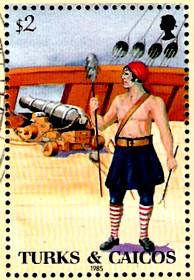
|
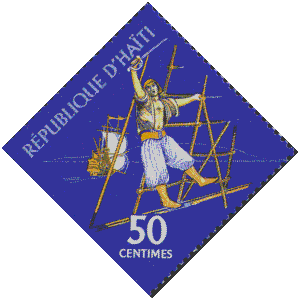
|
Piracy or robbery with ships happened since ships were build
in the beginning of mankind. But the period called the
'golden age of piracy'
is dated from 1690 to 1730. In these years the political and economical
situation combined with crying social injustice forced thousands of
despaired men to leave their homes and search for wealth and fortune on
the oceans.
Essentially they were American and English seamen, but French and other
nations took to the seas as well. Driven by their vehement desire for
liberty, adventure and wealth they plundered the coasts of North and South
America and Africa until no merchant-vessel was leaving a port without an
escort or in a convoy.
|
|
The Caribic Sea was turning into a pirate sea and the Bahama Islands to
a pirate empire. On the other side of the earth the island Madagascar was
the home of pirates and corsairs. From this point pirate fleets started to
plunder arabian an indian vessels carrying valuable goods. For many years the
pirates were sailing on the so-called 'Pirate Route' from North America
round the Cape of Good Hope into the Indian Ocean.
| 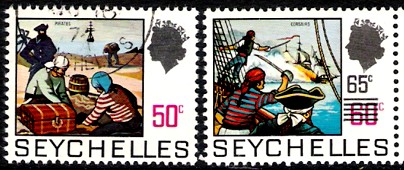
|
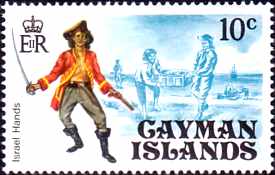
|
While they were chasing after gold and money the pirates were able to
accomplish great achievements in the fields of navigation and seamenship,
although they had quite contradictory characters. In an excited or drunken
state they were able to commit the most terrible cruelty. But there were
also moments of childlike sympathy and understanding.
On their vessels they executed a primitive code of democracy and justice.
Many cases were decided by voting and the distribution of treasuries
among them was regulated by an exact codex.
|
|
No writers were aboard the pirates ships. All we know about them was
written by imprisoned captains who used a chance to escape. And then there
was this journalist and writer Daniel Defoe (mostly known for his famous
novel 'Robinson Crusoe") who lived during those times.
He wrote two books about pirates, 'A General History of the Robberies and
Murders of the most Notorious Pyrates' published 1724 and another one
published in 1728 under his synonym Captain Charles Johnson.
|
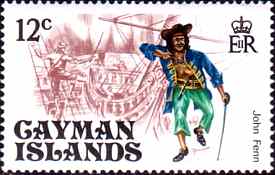
|

|
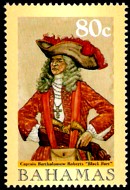
|
Most pirates were able bodied seamen coming from merchant vessels,
some had deserted the navy, others had been prisoners. The reason for
becoming a pirate was the strict discipline including unjust and cruel
punishment aboard many ships. The usual punishment consisted of 10 to 20
whiplashes.
During the 'Golden Age' an illegal but friendly connection existed between
the pirates and the american colonies. The pirates sold their
treasuries for special prices to the colonists. Gouvernors and custom
inspectors all along the coast were working hand in hand with them.
|
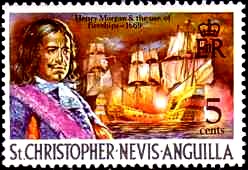
|
This is Sir Henry Morgan, a bucccaneer and later on vice gouvernor of Jamaica.
For most of his life he had an English letter of marque.
This letter legalized his robberies against the spanish colonies. He
plundered the rich city of Panama 1671, later on Puerto Bello, Maracaibo and
even Santiago (Cuba). After these successful raids he became too dangerous for
the English crown. He was appointed a knight and received the title 'Sir' and
a representative job on Jamaica.
|
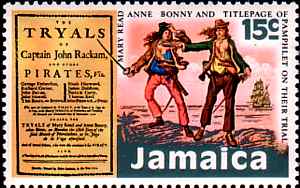
| |
Anne Bonny and Mary Read had a bloody role in the Caribic during
the age of piracy. Anne Bonny fall in love with the arrogant Jack Rackam,
called Calico Jack (in some books and on the stamp he was named John
instead of Jack).
Jack wanted to buy Anne. This was normal in those days, but her husband
didn't agree.
So Anne and Jack took to the seas for a lif of piracy. Once Jack pressed
another crew to work on his ship. Among them a handsome young man, and Anne
immediately fell in love again.
But what a pity, it was a young woman, Mary Read. They fought side by side
for many years. When they were caught they were both sentenced to death.
But as both were pregnant at this time, the jury
couldn't hang them.
Mary died in prison and Anne disappeared.
People said, her rich father had bought her freedom.
|
|
Edward Teach (Thatch) called Blackbeard was one of the
great pirate legends and a real one as well! As many other pirates Blackbeard
started out as privateer, a member of a ships crew authorized during the
Queen Anne's war to attack vessels belonging to France, Spain or any other
enemies of England. Also, like many pirates, he stayed at sea after the war
ended and joined a pirate crew.
|
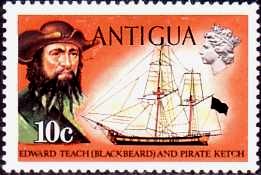
|
|
In his bloody, cruel, terrible and diabolic
'career' Blackbeard caught about 40 ships. His most notable act of terrorism
was his week-long blockade of Charleston, South Carolina 1718. In the same
year he was ambushed by the Royal Navy lieutnant Robert Maynard. Together
with his men he fought a terrific duel with Blackbeard. The pirate was hit
several times by pistol bullets and swords, but it took a long time until
Blackbeard finally collapsed on the deck. Maynard cut Blackbeard's head off
and hung it in front of his ship.
|
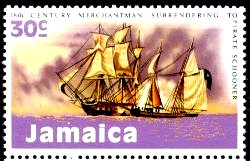
|
On the Blackbeard stamp above, to the left and the next below you see
pirate ships. These ships were smaller than the captured vessels. First of
all the pirate ships had to be fast and maneuverable. So they were build
small with only one or two masts and little draught; types consisted of
schooners, ketchs and brigantines. The merchant vessels were larger, heavier
and often they were fully loaded which made them incapable of fleeing.
|
|
The pirate flags were made to frighten the pirates opponents and enemies.
To strengthen the effect the flags showed horror symbols like skeletons,
swords, bowie knives, skulls, bones and hourglasses (representing 'time is
over'), mostly placed on a black background. The famous motive with a
deaths-head and crossing bones was first hoisted in 1700 by the French
privateer Emanuel Wynne. In England the pirate flag had the nickname
'Jolly Roger', possibly derived from the French 'joli rouge', translated
as 'nice red' (blood?!?).
|
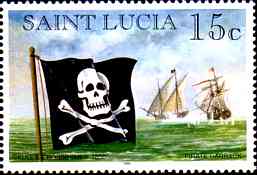
|
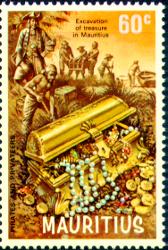
|
When captain Thomas Tew reached the port of Newport 1694, his ship 'Amity'
was loaded with unbelievable treasuries. Round about 100000 pounds in gold
and silver, trunks full of jewels and coins, an immense wealth in ivory
and spices and many packages with silk.
It is a known historical fact,
that captain William Kidd buried some of his treasuries on Gardiners Island.
The pirates divided their robberies adhering to an exact codex:
The captain and the quaterman got 2 parts, the chief at the guns and the
bosun 1.5 parts, all other 'officers' 1.25 parts and all other men 1 part.
|
|
The most successful pirate was Bartholomew Roberts. He captured over 400
ships in 4 years and then died in a fight with the 'H.M.S. Swallow'. The
'Swallow' was a 'man-of-war', 3 masts, 60 guns, with direct orders to chase
pirates.
On this stamp you see the 'Swallow sinks a pirate Macassar Strait'. The Royal
Navy had also sloops for chasing pirates. These sloops were constructed
especially for combat: small, length 65 feet,
one mast, little draught, high speed, 12 guns, 70 men and 7 pairs of rows
to turn the ship quickly in the right position for its guns.
|
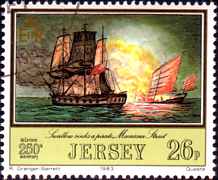
|
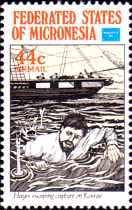
|
An example for piracy after the 'Golden Age': Bully Hayes, living from 1829
to 1877, traded slaves (blackbirds) to planters in the pacific region. In his
early years he played the trumpet in an orchestra. Then he came to the
South Sea and made money by selling poor natives. He was caught and played
the trumpet again in a church to shorten his sentence.
Again he started working as a slave trader throughout the Coral Islands.
Hayes died, killed by a drunken seaman from his own ship.
On the stamp you see Bully 'escaping capture'.
|
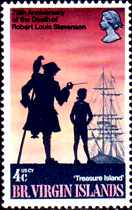
|
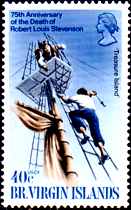
| |
Robert Louis Stevenson's famous book
'Treasure Island' with the one-legged cook Long John Silver, his parrot
and the fearless young boy Jim Hawkins,
1718, read by millions of young people around the world.
Walt Disney Productions made an exciting film about this voyage to the
'Treasure Island'.
|
You'll find stamps with the 'Pirate Theme' at Antigua, Bahamas, Bermuda,
British Virgin Island, Cayman Islands, Costa Rica,
France, Grenada-Grenadines, Haiti, Jamaica, Jersey, Mauritius, Mexiko, Micronesia,
Nicaragua, Paraguay, Saint Lucia,
St. Cristopher Nevis Anguilla, Seychelles, Tanzania,
Turks and Caicos Islands, Vietnam.
This list doesn't include the stamps of 'Sir Francis Drake' ......
|
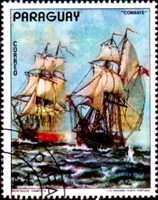
|
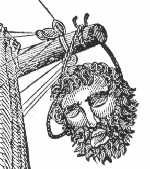
|
the end of Blackbeard, a historical fact!
|
|